Sphinx Biology
On this page, you will find a guide on the anatomy of a Sphinx, as well as their genetics system. This genetics system is not intended to limit player creativity in any way, and players do not need to strictly adhere to it- it will, however, be used when a pair of opposite-sex mates have a litter of kittens. You may design a Sphinx's markings however you please, as long as you can categorize them in some way genetically, or allow our moderators to do so for you.
A Sphinx's facial features and skin color are not defined genetically, and you may use whatever traits you please in those respects. A Sphinx's size and body type are also not regulated, though most sphinxes are usually no more than five feet tall at the shoulder, and no less than three.
Body Comformation
A Sphinx is a quadrupedal creature with the body of a cat, articulated hand-paws on their front limbs, a long neck, and a human face. Their fur can vary in length, but it usually gets longer on the neck and especially on the head, forming hair. Sphinx have a variety of mutations which can change how their body looks. Most of these mutations are free to use, and any player can use them when making a character, however a few are restricted for lore purposes.
Common Mutations
Free to Use on any character.
50% Chance of Passing to Offspring

Feather Accents
Feather accents are any small gatherings of feathers on the body, such as on the wrists, hips, or neck. Tiny, functionless wings are also counted as feather accents.
Curly Fur
The sphinx's fur is wavy or curly.
Mane
The sphinx's neck, chest, and/or back are covered in a long, fluffy mane, like a lion. The mane can stretch down the front legs, and all the way down the spine to the end of the tail.
Mammalian Tail
The tail of any mammal. Yes, any.
Fins
Skin or leather fins which are held up by some amount of tines. These fins can be thin and wavy, like the silky fins of a beta fish, or stretched tightly between the tines, like a bat's wings. Small, non-functional bat wings would also be counted as fins.
Hair
Fur on the top of the head becomes hair, growing ceaselessly and requiring regular cutting. Can also present on the tail, as well as in a horse-like mane.
Uncommon Mutations
Newly created characters may have 1 free uncommon mutation, others may be gained via tonics or breeding.
30% Chance of Passing to Offspring

Feather Cloak
Feathers cover the back in a cloak pattern. Often accompanies feathered wings.
Hairless
The sphinx's fur is not present, however hair may still grow on the head.
Overgrown Claws/Fangs
The sphinx's canine teeth and/or claws are uncommonly long.
Non-Mammalian Tail
Any tail in the animal kingdom.
Rare Mutations
May be obtained through via tonics or breeding.
10% Chance of Passing to Offspring

Wings
The character has one to three pairs of functional wings of some sort. Feathered, insectoid, or bat-like are all covered by this mutation.
Glow
Some amount of the Sphinx glows, can be anything from a single marking to the whole body.
Iridescence
The sphinx's fur, feathers, and/or hair take on an iridescent sheen, changing colors depending on where the light hits it.
Non-Human Face
The sphinx has non-human facial features. This can range from having a cat's nose all the way to having the head of a different creature, as pictured in the example above.
Genetics
The genetics system employed by Forest of Sphinxes is a stylization of real cat genetics. I have sunk many, many hours into the study of cat genetics, and am purposefully simplifying things for the sake of the roleplay. That said, while this system will not be a direct comparison to cat genetics, it may still be complicated and confusing. Don't be afraid to ask for help if you need it for any reason!
Base Colors
A Sphinx's Base Color determines what the darkest color on it's coat is. This is the color of a tabby's stripes, or the patches on a calico's white fur! Forest of Sphinxes does not enforce hard realism, and as such, each base color can be interpreted in several different ways, from their natural presentation to more unnatural colors inspired by their real-life counterparts. Each base color is given three examples which span the spectrum from natural to fantasy interpretations of their colors.While Forest of Sphinxes does not enforce hard realism, we do limit colors which are intensely saturated or "neon". Neon colors may be used as accents in a design, but may not be used as the base color as a whole. See examples at the bottom of the base colors list.
Base Color Genetics
These are the genes which contribute to a sphinx's base color.
Brown Dilution - The B Gene
Brown Dilution, as it's name suggests, dilutes any black in the coat to lighter brown shades. There are 2 recessive mutations of this gene, one which causes Chocolate, a rich brown, and one which causes Cinnamon, a lighter orange-brown.
BB - Black
Bb - Black, carrying Chocolate
Bb1 - Black, carrying Cinnamon
bb - Chocolate
bb1 - Chocolate, carrying Cinnamon
b1b1 - Cinnamon
Maltese Dilution - The D Gene
Maltese Dilution causes a sphinx's coat to become lighter and less saturated, resulting in a diluted coat. It is a recessive trait, and it affects all base colors. Black becomes Blue, Chocolate becomes Lilac, Cinnamon becomes Fawn, and Red becomes Cream. A non-diluted coat is known as a "Dense" coat, named for the density of pigment cells in the skin and fur.
DD - Dense
Dd - Dense, carrying Dilute
dd - Diluted
Red - The O Gene
A red coat in Sphinxes is inherited via the O gene. Red is an incompletely dominant gene, meaning that a sphinx with mixed red genes will show a partially red coat- called a tortoishell or a calico depending on how much white is in the coat- and a sphinx with two red genes will show a 100% red coat.
Note: In real-life cats, there is a widely known phenomenon that only females can be tortoishell/calico. This is caused by the O gene being carried on the X chromosome, causing tortoiseshell to become linked to a cat's sex. As male cats only have one X chromosome, they can only inherit one O gene, making them either Red(XOY) or Non-Red(xoY). Females however, which inherit two X chromosomes, have a chance of being Tortoishell, as they can inherit two O genes: Red(XOXO), Tortoishell(XOxo), or Non-Red(xoxo).
Forest of Sphinxes does not follow this rule. We have intentionally removed the link to the X chromosome, meaning that red genes in Forest of Sphinxes are inherited independently of a sphinx's sex. Thank you for understanding.
OO - Red
Oo - Tortoishell/Calico
oo - Non-Red (Black, Chocolate, or Cinnamon, depending on B gene)
Dense Base Colors:
These colors are not diluted, meaning they are very rich in color!

Black
A Black base coat may be any reasonably dark color, from a dark grey to deep green to the red pictured above. They must look dark, if not black, however that is the only limit.

Chocolate
Chocolate bases must be a dark brown, and are, in general, one of the least variable bases. However, a chocolate sphinx may run anywhere along the higher half of the saturation spectrum, allowing for very richly colored characters.
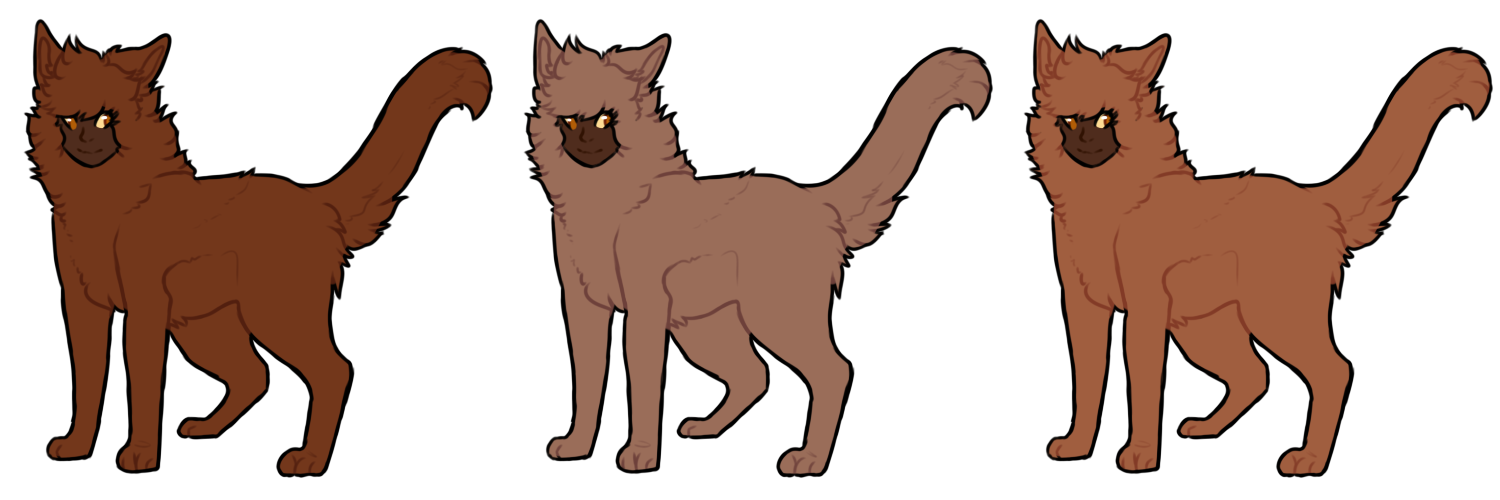
Cinnamon
Cinnamon sphinxes are light, orange-brown sphinxes whose colors can run the gamut from ashy grey-brown to bright, nearly-red oranges.

Red
A Red base coat may be any orange-to-red color that is not too dark or too eyeburning.
Diluted Base Colors:
These coats are diluted, meaning they are generally lighter than their "Dense" counterparts. Remember, skin tones are not linked to coat color genetics! A lighter tone was just used to match with the lighter colors.

Blue
A Blue base coat should be a grey to blue color, though it may stray into periwinkle or teal as well, as long as the color is not too saturated.
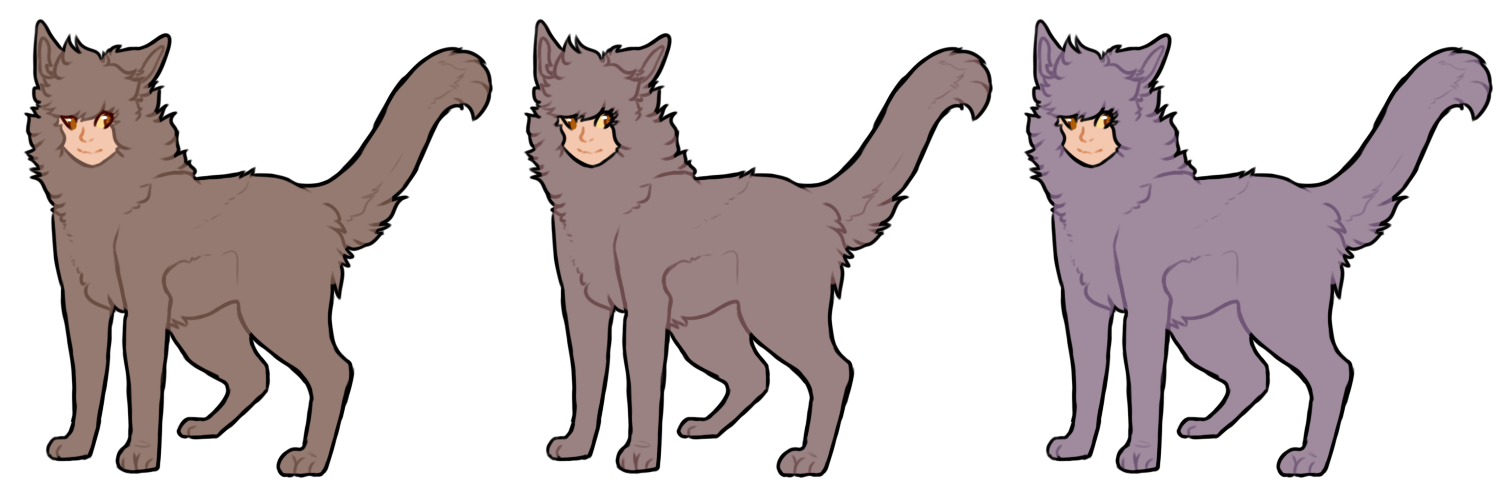
Lilac
A Lilac base coat may be any color from light grey-brown to tan to lavender.
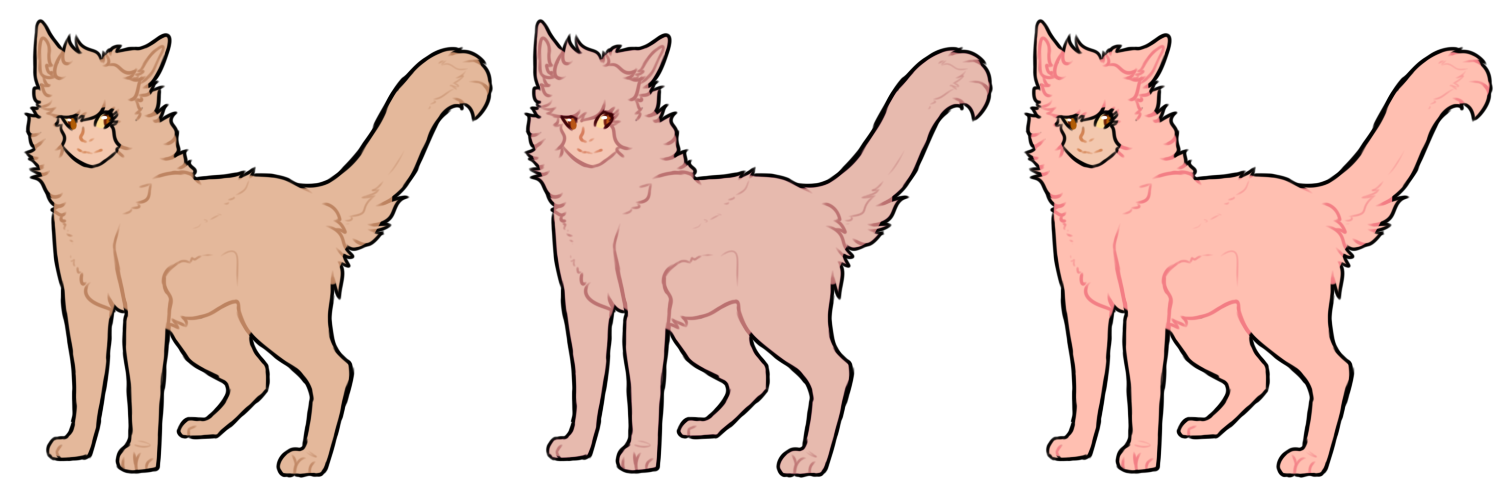
Fawn
Fawn base coats may range from light tan, to cream, to pink.
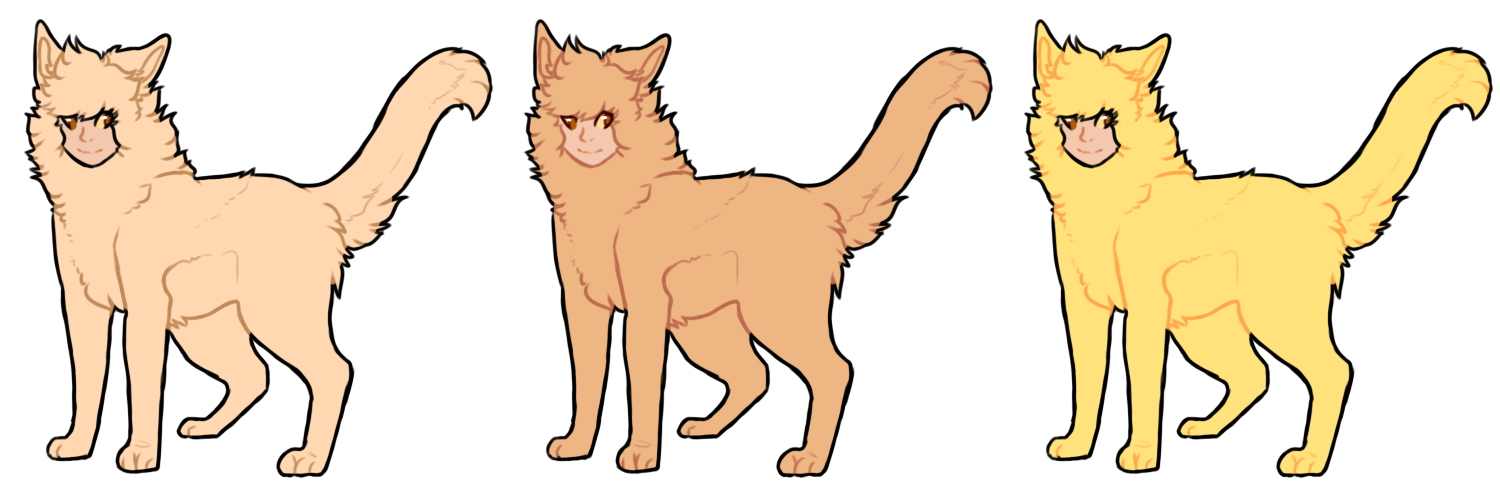
Cream
A Cream base coat may be any light orange to yellow color that is not too neon.
Tortoiseshells and Calicos:
Tortoiseshells are created when a Sphinx has just one copy of the Red gene, causing their coat to display both Red and non-red hairs. The Non-red hairs may be Black, Chocolate or Cinnamon.

Tortishell vs Calico
As a tortoisehell sphinx gets more and more white markings on it's coat, it's red and non-red hairs separate into patches, as pictured above. A Tortoishell is named for whatever it's non-red color is, for example, the sphinxes above would be called "Black Tortoishell".
Please also make sure that you match dilution types, for example, a Lilac Tortoishell would have Cream patches, not red. Also, as tortoishells are a mix of Red and Non-Red, there are no Black-Cinnamon, Chocolate-Fawn, or other torties which are a mix of Black, Chocolate, Cinnamon or their diluted versions.
Neon Colors and How To Use Them:
Forest of Sphinxes does not enforce harsh realism, however, we still limit the use of overly bright or "Neon" colors. We request that these colors be used as accents in your Sphinx's design, and not their main colors. Accessories and paint are of course, not limited by this rule- only your Sphinx's natural markings.
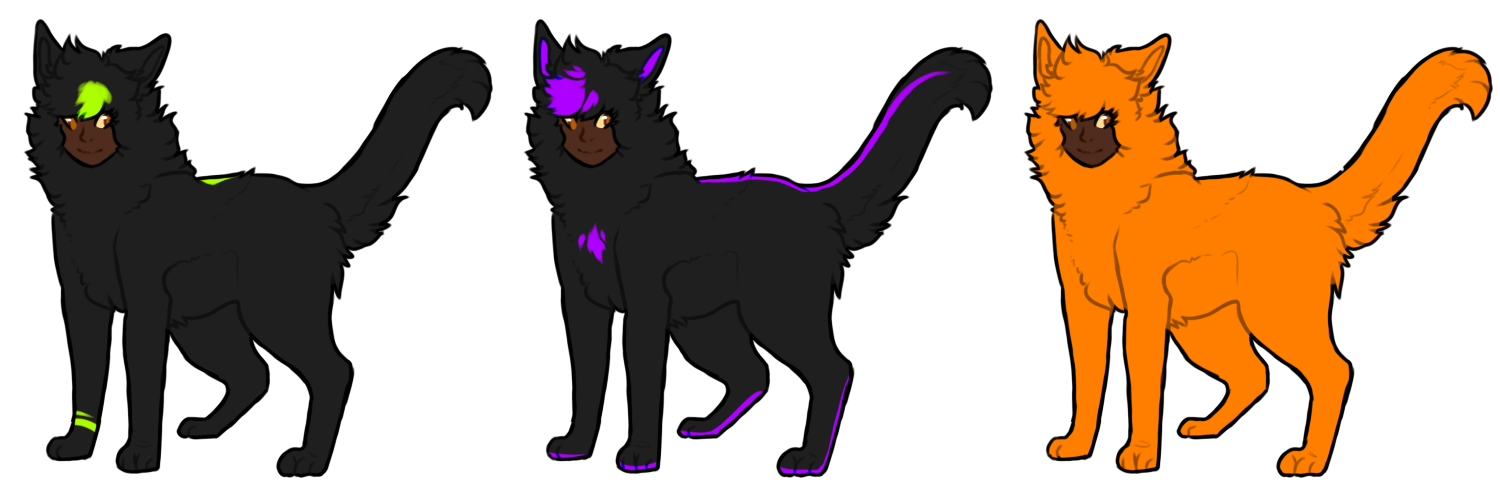
Correct Uses of Neon
Neon colors may be used as accents in a design, such as in the center of rosettes, in the eyes, mouth, flesh, or pawpads, or in small accent markings as detailed above. In addition, neon orange is exempt from the "No Neons" rule, as it can be used for the base color of a Red-Based Sphinx.

Incorrect Uses of Neon
Neon colors- those being highly bright and saturated colors- may not take up more than 30% of the coat, so as not to overwhelm the design, and neon colors should not be used as the base of your sphinx's palette.
Tabby Types
The common tabby type for a sphinx is stripe shapes, however there are also two modifiers which may affect the shape of the stripes, breaking them up into spots or even changing the banding on the hairs entirely. The patterns displayed by sphinxes are not limited to the feline animal family- you do not even have to stick to real animal patterns as long as they fit into one of the following categories.The stripes of a tabby are always their base color, with the "background" color of their coat taking on a lighter shade, sometimes with a more saturated tint. However, there are many variations to different tabbies, and you are not limited to strict realism. Forest of Sphinxes encourages it's players to search up varying tabby-affecting genes, as there were many that, unfortunately, were a bit too complicated to include, such as Charcoal, Sunshine, Siberian Golden, Amber and Russet. Any of these phenotypes are available for players to use in their designs! They are just not defined in our group's genetics system.
Tabby Genetics
These are the genes which affect how a tabby coat may present.
Tabby Phenotypes
Agouti - The A Gene
The Agouti gene acts as a switch for the tabby pattern as a whole. If a sphinx has two copies of the recessive Agouti gene, their coat will show no tabby at all.
AA - Agouti
Aa - Agouti, carrying Solid
aa - Solid
Spotting - The S Gene
The spotting gene acts as a modifer to the common Striped pattern, gradually breaking it into spots.
SpSp - Spotted
Spsp - Broken (Mix of Spots and Stripes)
spsp - Striped
Ticked - The T Gene
The Ticked gene is another modifer for the tabby pattern, however this one completely breaks down the stripes and causes the hairs to be ticked or banded in such a way as to show very little stripes or spots at all.
TT - Ticked
Tt - Ticked, carrying Non-Ticked
tt - Non-Ticked
These are the different shapes a sphinx's tabby may take. They are meant to encompass any pattern that could feasibly fit under their label, for example, stripes can be anything from tigers to gazelle stripes to tapirs.

Striped Tabby
Commonly, sphinxes are marked by stripes of any kind, from mackerel tabby to tiger stripes. Striped Tabby markings are solid all the way through, and do not break into spotting except on the belly.
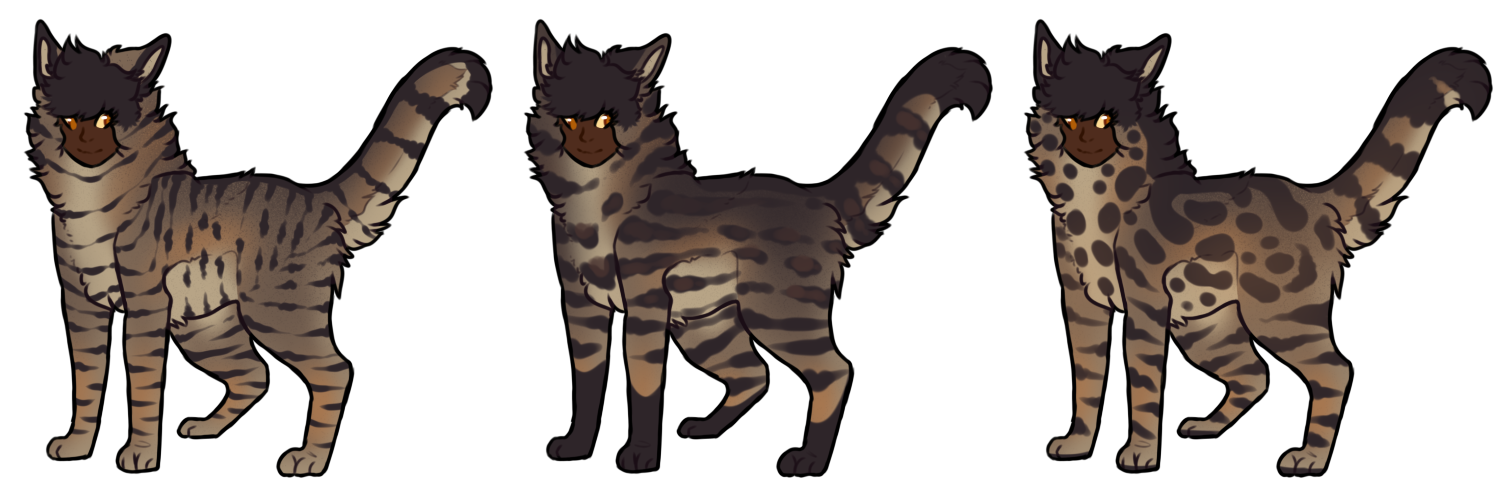
Broken Tabby
Broken Tabby sphinxes have one copy of the Spotting gene, causing their pelt to show a mix of stripes and spots.

Spotted Tabby
A sphinx with two copies of the Spotting gene displays a spotted or rosetted coat.

Ticked Tabby
Any sphinx with at least one copy of the Ticking gene will display an agouti pattern which does not display stripes or spots.
Silver and Gold
The Inhibitor and Wideband genes in sphinxes can combine in many different ways to create different Silver and Gold phenotypes. The Wideband gene changes how much of the sphinx's coat is affected, while the Inhibitor gene desaturates and lightens the areas of the sphinx's coat which are affected. In the affected areas, the sphinx's tabby stripes will be visible, even if they are otherwise solid.When a tabby sphinx has Wideband, then it's background color will be a light gold.
When a tabby sphinx has Inhibitor, then it's background color will be silver.
When a tabby sphinx has both, then it's background color will be white.
Silver and Gold Genetics
These are the genes which cause the silver and gold effects.
Silver and Gold Phenotypes
Inhibitor - The I Gene
The Inhibitor gene removes- or inhibits- the production of orange and yellow pigments, causing any bands of pheomelanin present in the coat to be bleached white rather than the brown, yellow, or orange they had been before. This effect is called Silver for it's striking appearance when on a black coat.
II - Silver
Ii - Silver, carrying Self
ii - Self
Wideband - The Wb Gene
The wideband gene causes any bands of pheomelanin - that is, yellow or orange pigment - to be widened, resulting in Tabby sphinxes becoming lighter in color, and Solid sphinxes having their tabby partially revealed. It is often used in conjunction with Inhibitor to allow for wider bands of Silver to be visible in the coat.
WbWb - Wider Band
Wbwb - Wide Band
wbwb - Self
These are the different ways that Inhibitor and Wideband can interact on a solid black sphinx, giving different effects depending on the combination used.

Self
It may go without saying, but a sphinx without the Wideband nor Inhibitor genes is just a normal sphinx.
Smoke
A sphinx with the Inhibitor gene but no Wideband is a Smoke, showing silver very faintly on it's undersides.
Golden Shaded
A sphinx with one copy of the Wideband gene, and no Inhibitor will show golden undersides.
Silver Shaded
A sphinx with one copy of the Wideband gene and Inhibitor will show silver undersides.
Golden
A sphinx with two copies of the Wideband gene, and no Inhibitor will show a golden base.
Silver
A sphinx with two copies of the Wideband gene Inhibitor will show a silver base.
Colorpoint and Albino
The Colorpoint gene in sphinxes causes the fur in the center of their body to become lightened. Another mutation on the same gene causes the sphinx to lose all color, displaying a white coat and pink or pale blue eyes.Colorpoint Genetics
These are the genes which cause the colorpointed pattern, as well as albinism in sphinxes.
Colorpoint and Albino
Colorpoint - The C Gene
Mutations of the C gene cause some proteins involved in the production of pigments to become sensitive to heat. The Colorpointed mutation only partially causes this sensitivity, meaning color still pokes through, however the albinism gene completely breaks these proteins, causing the sphinx's body to have no color at all.
CC - Self
Ccs - Self, carrying Colorpoint
Cc - Self, carrying Albino
cscs - Colorpoint
csc - Colorpoint, carrying Albino
cc - Albino
Pictured below are two of the many ways colorpoint can present, as well as an example of albinism in Forest of Sphinxes.

Pointed
A sphinx with two copies of the Pointed gene, or one copy of the Pointed and one copy of the Albino gene, will display some amount of colorpointing, from a Siamese to a Burmese pattern.
Albino
A sphinx with two copies of the Albino gene will display a white coat and light blue or pink eyes.
White Markings
A sphinx with at least one copy of the Dominant White gene will show a fully white coat. Alternatively, a sphinx with at least one copy of the White Spotting gene will show white markings. White markings are highly variable, and can display in any pattern in the animal kingdom.White Marking Genetics
These are the genes which cause the various white patterns in sphinxes.
White Markings
White Spotting - The W Gene
There are two different mutations to the W gene, both of which are dominant to normal self coloration. One causes the whole coat to become white, while the other causes the sphinx to present white markings. As with tabby types, Forest of Sphinxes uses a simplified genetics system and, as such, cannot genetically define every pattern. This means that white spotting in Forest of Sphinxes can cause any white pattern you can think of.
WW - Dominant White
Wws - Dominant White, carrying White Spotting
Ww - Dominant White, carrying Self
wsws - White Spotted
wsw - White Spotted, carrying Self
ww - Self
Pictured below are just two of the many shapes white spotting can take, as well as an example of Dominant White.

Dominant White
A sphinx with at least one copy of the Dominant White gene will display a purely white coat.
White Spotting
A sphinx with at least one copy of the White Spotting gene will display white markings. The white can cover any from 10% to 90% of the coat.
